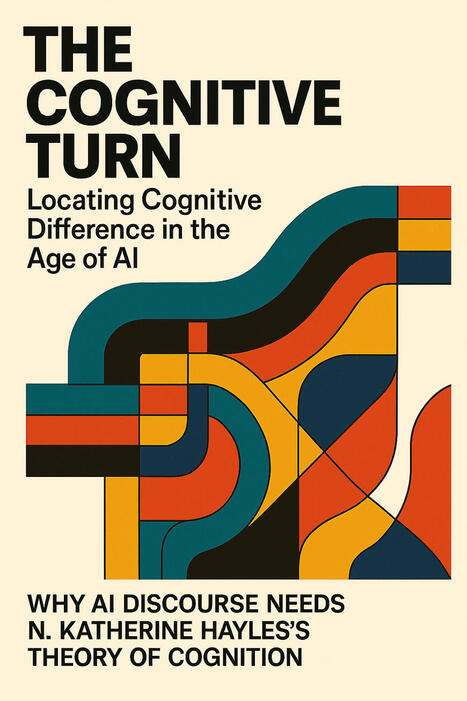La confluencia entre sistemas cognitivos artificiales y entornos académicos redefine la ingeniería pedagógica hacia modelos adaptativos y autorregulados de conocimiento. Estas arquitecturas no solo interpretan el lenguaje humano, sino que lo reconceptualizan como vector de aprendizaje emergente y colaborativo. La sinapsis entre redes neuronales profundas y bases epistémicas universitarias permite una retroalimentación semántica que transforma datos en sabiduría compartida. Esta nueva cosmogonía algorítmica abre rutas hacia una ciencia expandida donde los agentes IA actúan como coautores del pensamiento. La exploración futura reside en perfeccionar estos sistemas para cultivar inteligencias simbióticas entre máquinas y humanos.
Get Started for FREE
Sign up with Facebook Sign up with X
I don't have a Facebook or a X account


 Your new post is loading... Your new post is loading...
 Your new post is loading... Your new post is loading...
From
arxiv
This paper introduces "GAIDE: Generative AI for Instructional Development and Education," a novel framework for using Generative AI (GenAI) to enhance educational content creation. GAIDE stands out by offering a practical approach for educators to produce diverse, engaging, and academically rigorous materials. It integrates GenAI into curriculum design, easing the workload of instructors and elevating material quality.
With GAIDE, we present a distinct, adaptable model that harnesses technological progress in education, marking a step towards more efficient instructional development. Motivated by the demand for innovative educational content and the rise of GenAI use among students, this research tackles the challenge of adapting and integrating technology into teaching.
GAIDE aims to streamline content development, encourage the creation of dynamic materials, and demonstrate GenAI's utility in instructional design. The framework is grounded in constructivist learning theory and TPCK, emphasizing the importance of integrating technology in a manner that complements pedagogical goals and content knowledge.
Our approach aids educators in crafting effective GenAI prompts and guides them through interactions with GenAI tools, both of which are critical for generating high-quality, contextually appropriate content. Initial evaluations indicate GAIDE reduces time and effort in content creation, without compromising on the breadth or depth of the content.
Moreover, the use of GenAI has shown promise in deterring conventional cheating methods, suggesting a positive impact on academic integrity and student engagement. If you’re an instructional designer, you’ve probably noticed how everything has changed over the past few years. What used to take us weeks to create can now be done in days thanks to artificial intelligence. Learners are no longer satisfied with boring PDFs—they want interactive experiences that engage them from the very first moment.
From
arxiv
This study explores the neural and behavioral consequences of LLM-assisted essay writing. Participants were divided into three groups: LLM, Search Engine, and Brain-only (no tools).
Each completed three sessions under the same condition. In a fourth session, LLM users were reassigned to Brain-only group (LLM-to-Brain), and Brain-only users were reassigned to LLM condition (Brain-to-LLM). A total of 54 participants took part in Sessions 1-3, with 18 completing session 4. We used electroencephalography (EEG) to assess cognitive load during essay writing, and analyzed essays using NLP, as well as scoring essays with the help from human teachers and an AI judge.
Across groups, NERs, n-gram patterns, and topic ontology showed within-group homogeneity. EEG revealed significant differences in brain connectivity: Brain-only participants exhibited the strongest, most distributed networks; Search Engine users showed moderate engagement; and LLM users displayed the weakest connectivity.
Cognitive activity scaled down in relation to external tool use. In session 4, LLM-to-Brain participants showed reduced alpha and beta connectivity, indicating under-engagement. Brain-to-LLM users exhibited higher memory recall and activation of occipito-parietal and prefrontal areas, similar to Search Engine users.
Self-reported ownership of essays was the lowest in the LLM group and the highest in the Brain-only group. LLM users also struggled to accurately quote their own work. While LLMs offer immediate convenience, our findings highlight potential cognitive costs. Over four months, LLM users consistently underperformed at neural, linguistic, and behavioral levels. These results raise concerns about the long-term educational implications of LLM reliance and underscore the need for deeper inquiry into AI's role in learning. The Artificial Intelligence revolution is transforming higher education at an unprecedented pace, offering innovative opportunities to personalize university learning experiences, support professors and researchers in their daily tasks, and optimize the management of educational institutions. Higher Education in Latin America and the Caribbean requires urgent and creative actions to overcome the challenges affecting millions of university students in the region. Our goal is to provide the necessary tools to ensure that institutions and students make the most of the opportunities offered by AI. The report highlights areas such as:
This report is part of the Digital Innovations in Education for Latin America and the Caribbean series. These academic studies and reports are designed to maximize the use of technology and encourage the effective application of digitalization in education.
From
es
Vivimos un momento que es impresionante y desafiante a la vez: herramientas de IA que parecen sacadas de una película de ciencia ficción están al alcance de todos. Hoy cualquiera puede generar un correo, una presentación o un discurso en segundos... aún sin saber escribir profesionalmente.
Sin embargo… todo empieza a sonar igual. Las redes, los correos, las respuestas, los discursos.... todo suena igual. Los mensajes son técnicamente correctos, pero emocionalmente planos. Brillantes por fuera, vacíos por dentro. Imagine having access to your target learners' thoughts, behaviours and emotional responses throughout your entire design process. While this may seem like science fiction (and, perhaps, risky), recent research by Park et al. (2024) demonstrates that AI personas built from intentionally gathered, structured data can predict learner behaviour more accurately than traditional human-centred approaches, achieving approximately 85% accuracy in behavioural simulation and prediction. The use of Artificial Intelligence (AI) in education has the potential to further customise and personalise students’ learning, and encourage self-directed learning. It can also augment teachers’ professional practice by automating routine tasks and allowing teachers to spend more time with students and provide more complex guidance to advance learning. However, inappropriate AI use may impede the development of critical thinking skills in students or propagate misinformation.
In Singapore, the Infocomm Media Development Authority (IMDA) has introduced the Model AI Governance Framework to guide the responsible deployment of AI solutions. The Implementation and Self-Assessment Guide for Organisations (ISAGO) was also created to help organisations align their AI governance practices with the Model AI Governance Framework.
Specifically, the Ministry of Education has developed the AI-in-Education (AIEd) Ethics Framework, which builds on the Model AI Governance Framework to address education-specific use and risks, and incorporates key beliefs from the Ethos of the Teaching Profession.
From
www
¿Nunca te has preguntado por qué todos seguimos el mismo patrón? Es decir, cuando vamos a la escuela, aunque de niños todos pensamos de manera diferente, nos imparten la misma educación, la misma ideología, los mismos contenidos. Picture this: a learner on a course you designed opens their laptop and types into ChatGPT: "I want to learn by teaching. Ask me questions about calculus so I can practice explaining the core concepts to you."
From
www
I honestly don’t know how I should be educating my kids. A.I. has raised a lot of questions for schools. Teachers have had to adapt to the most ingenious cheating technology ever devised. But for me, the deeper question is:
From
www
Over the past several years, educators have produced a seemingly endless string of task force reports, policy statements, op-eds, and other forms of hand-wringing about the role of AI in writing. But few have recognized what is abundantly obvious to pretty much everyone under the age of 25—that today’s young people will inhabit a future where the vast majority of writing will be produced using AI.
From
www
Research by the student accommodation company Yugo reveals that:
Schools and Universities to go obsolete? Godfather of AI, Greoffrey Hinton says 'we won't need them'Geoffrey Hinton, the "godfather of AI," predicts AI tutors will surpass human tutors within a decade, leveraging vast data to personalize learning. These AI systems could be significantly more effective, potentially disrupting traditional universities. Reactions highlight AI's integration into education and its potential to revolutionize personalized learning, raising concerns about the future of computer science programs. |
In a recent Boston Globe op-ed, two researchers proposed a linguistic fix to an ontological dilemma: rename our relationships with AI. Rather than referring to generative systems as “coworkers” or “collaborators,” they suggest we replace the human “co-” with a machine-coded “c0-”: c0worker, c0creator, c0mpanion. The goal is to reassert the boundary between human and machine by embedding it in our language—clarity by typography. La confluencia entre sistemas cognitivos artificiales y entornos académicos redefine la ingeniería pedagógica hacia modelos adaptativos y autorregulados de conocimiento. Estas arquitecturas no solo interpretan el lenguaje humano, sino que lo reconceptualizan como vector de aprendizaje emergente y colaborativo. La sinapsis entre redes neuronales profundas y bases epistémicas universitarias permite una retroalimentación semántica que transforma datos en sabiduría compartida. Esta nueva cosmogonía algorítmica abre rutas hacia una ciencia expandida donde los agentes IA actúan como coautores del pensamiento. La exploración futura reside en perfeccionar estos sistemas para cultivar inteligencias simbióticas entre máquinas y humanos.
From
www
The AI in Education Leadership Catalyst community of practice was intentionally designed to foster the strategic leadership and collaborative networks necessary to navigate the complex implications of generative AI. As co-designers, we envisioned a space where leaders could contemplate big questions: How do we lead with integrity when the ground beneath us may be shifting? How do we center pausing and introspection in an era of AI? And, most importantly: How can we design learning experiences that are as adaptive and resilient as the leaders we serve? El universo tecnológico en el que estamos inmersos provoca cambios en el cerebro humano, que, plástico y moldeable como es, responde adaptándose a nuevos estímulos y experiencias. ¿Cómo lo hace? ¿Qué consecuencias tienen estos cambios a corto plazo? Y a largo, muy largo plazo, ¿marcará el cerebro digital un nuevo paso en la evolución humana?
From
www
The rise of artificial intelligence has schools racing to respond to tools like ChatGPT. While some fear it may replace teachers and erode human connection, others see it as a chance to transform and improve education.
From
rcepunesco
As education shifts from traditional content delivery to students to teaching students how to develop and employ agile, critical thinking, and problem-solving skills, the teacher's role is being redefined. This transformation is essential to meet the United Nations' Sustainable Development Goal 4 (SDG 4), specifically targets 4.1 and 4.A, which aim to ensure inclusive and equitable quality education and promote lifelong learning opportunities for all.
This shift is driven by the imperative to prepare students for scenarios that do not yet exist, requiring a fundamental rethinking of teaching methodologies and the competencies that educators need to develop. This shift thus requires us to embrace change as
Edumorfosis's insight:
Si bien los métodos tradicionales suelen contar con investigaciones de eficacia comprobada, los docentes necesitan adoptar y adaptar herramientas digitales que les ayuden en la preparación y la impartición de la instrucción (German et al., 2022).
En las aulas del futuro, el docente no será la única fuente de información ni el centro de atención del aula. En cambio, será guía y mentor, facilitando el aprendizaje mientras los estudiantes navegan por un mundo de pantallas holográficas, simulaciones de realidad virtual y herramientas de aprendizaje impulsadas por IA. El docente ayudará a los estudiantes a conectar conceptos, aplicar sus conocimientos creativamente y ampliar los límites de su pensamiento. El futuro docente es un facilitador de la creatividad y la innovación, experto en estrategias que ayudan a los estudiantes a dirigir sus propios procesos de aprendizaje (Royce, 2023; Shippee, 2019).
From
futurism
Hearing the horror stories they have to share, it's not hard to see why Gehl and other educators feel that way. A Los Angeles-based teacher grimly estimated that 40% of the work that came across their desk "is touched by the hand of AI." Another who teaches postgrads was appalled that their students in a doctoral program about responsible AI gave in to lazily using the tech.
Edumorfosis's insight:
¡FALSO! La IA no está destruyendo el Sistema Educativo. Es el mismo sistema el que se obsoletiza y se convierte en irrelevante. A dos años y medio del lanzamiento de GPT el sistema educativo no ha hecho nada para transformarse a sí mismo, mientras GPT ha tenido varias actualizaciones de su propia plataforma. El ADN del sistema está hecho para mantener el continuismo y perennialismo educativo a lo largo de las décadas. Cambiarán las aulas, cambiarán los laboratorios, cambiarán los entornos de enseñanza, pero la Educación sigue siendo la misma de siempre. Su modelo operacional sigue siendo pedagógico desde el Jardín de Infancia hasta el nivel Doctoral. ¿Donde está el cambio? Mis clases doctorales se dieron en el mismo entorno que tiene la escuela elemental y superior. También se dictaron en el mismo formato, con la diferencia de que ahora se utiliza PowerPoint para mostrar diapositivas.
From
es
Los nativos en IA no ven a ChatGPT, Midjourney o Copilot como simples herramientas. Los experimentan como extensiones de su mente. Escribir con IA no es “hacer trampa”, como temen algunos docentes, sino dialogar con una inteligencia que propone, reformula, sugiere, y que necesita ser guiada con criterio, con preguntas precisas y pensamiento crítico.
From
www
En este vídeo descubrirás el origen oscuro del sistema educativo y cómo fue diseñado por las élites para adoctrinar, manipular y fabricar obedientes trabajadores. Desde Prusia hasta Rockefeller, entenderás cómo convirtieron la educación en una herramienta de control masivo y en uno de los negocios más rentables de la historia. Esta no es una teoría: son hechos históricos que te abrirán los ojos. Si alguna vez sentiste que algo no cuadraba… esto lo explica todo. When Sir Ken Robinson delivered his now-iconic TED Talk in 2006, proclaiming that “schools kill creativity,” he struck a chord that continues to reverberate through education systems worldwide. Robinson’s argument that our schools systematically squash imagination in favor of conformity and compliance sparked a movement for more creative, learner-centered approaches. Yet, less than two decades later, a new fear is echoing through these same halls: that artificial intelligence will now be the force that finally kills critical thinking in schools. How did we get from blaming the system to blaming the tool?
Edumorfosis's insight:
La nueva pregunta sería: La creatividad IA está matando la escuela?
From
www
Neuroscience has long supported the idea that our brains need to be used to stay strong. Our brains aren't fixed; they are active, adaptable structures capable of amazing change, a process known as neuroplasticity. When we do challenging mental tasks – like learning a new language, solving a difficult problem, or even finding our way in an unfamiliar city – our brains build new connections and strengthen existing ones. If we don't give our brains enough mental stimulation, our thinking abilities can decline.
From
www
For many college students these days, life is a breeze. Assignments that once demanded days of diligent research can be accomplished in minutes. Polished essays are available, on demand, for any topic under the sun. No need to trudge through Dickens or Demosthenes; all the relevant material can be instantly summarized after a single chatbot prompt.
Welcome to academia in the age of Artificial Intelligence. As several recent reports have shown, outsourcing one’s homework to AI has become routine. Perversely, students who still put in the hard work often look worse by comparison with their peers who don’t. Professors find it nearly impossible to distinguish computer-generated copy from the real thing — and, even weirder, have started using AI themselves to evaluate their students’ work. |


![[PDF] GAIDE: A framework for using Generative AI to assist in Course Content Development | Edumorfosis.it | Scoop.it](https://img.scoop.it/iMtIhVYOvt6fW6J15uaAtjl72eJkfbmt4t8yenImKBVvK0kTmF0xjctABnaLJIm9)

![[PDF] Your Brain on ChatGPT: Accumulation of Cognitive Debt when using an AI Assistant for essay writing task | Edumorfosis.it | Scoop.it](https://img.scoop.it/TIYYjbxL97Sr1U399ncejjl72eJkfbmt4t8yenImKBVvK0kTmF0xjctABnaLJIm9)
![[PDF] AI revolution in Higher Education: What you need to know | Edumorfosis.it | Scoop.it](https://img.scoop.it/P3BF6_LI0ziOF7GcmT54sTl72eJkfbmt4t8yenImKBVvK0kTmF0xjctABnaLJIm9)



![[documental] El sistema educativo representa la mayor trampa del mundo moderno I Schopenhauer y Nietzsche | Edumorfosis.it | Scoop.it](https://img.scoop.it/gOkgVPiL-_3BN9eB8mGArjl72eJkfbmt4t8yenImKBVvK0kTmF0xjctABnaLJIm9)

![[Video] Educating kids in the Age of AI | Edumorfosis.it | Scoop.it](https://img.scoop.it/vj4QFJ5ttxPWjOL00ixwUzl72eJkfbmt4t8yenImKBVvK0kTmF0xjctABnaLJIm9)






![[Video] Will AI replace teachers in classrooms? | Edumorfosis.it | Scoop.it](https://img.scoop.it/f_gcMGZe97woOxNJDOhKHDl72eJkfbmt4t8yenImKBVvK0kTmF0xjctABnaLJIm9)
![[PDF] Futuristic insights on Education components: How education can meet the demands of an ever-changing world | Edumorfosis.it | Scoop.it](https://img.scoop.it/ct67-p-Vzwuz9CPH4eP7Kjl72eJkfbmt4t8yenImKBVvK0kTmF0xjctABnaLJIm9)









